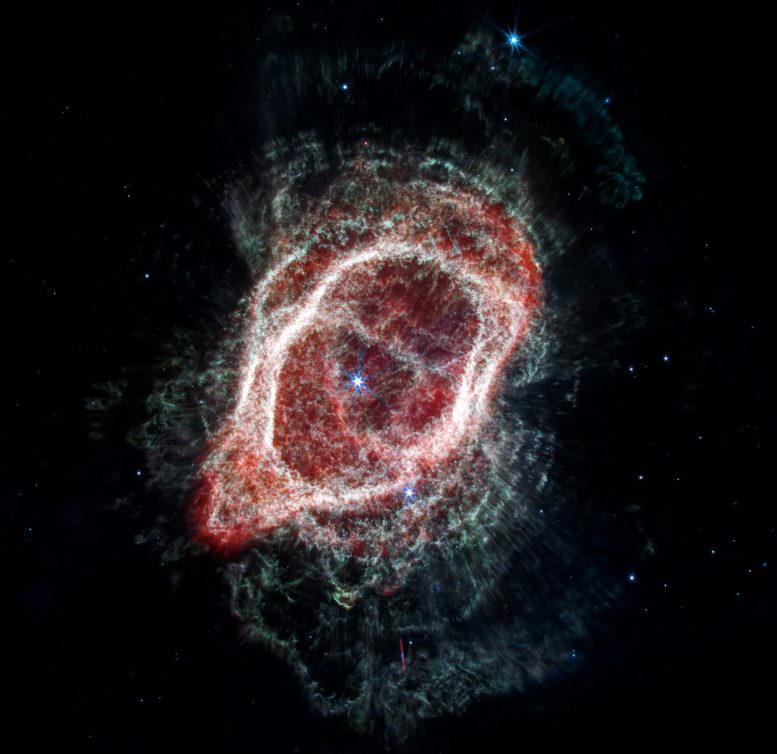
This image of the Southern Ring Nebula (NGC 3132) was captured by Webb’s Near-Infrared Camera (NIRCam) and Mid-Infrared Instrument (MIRI). Credit: Science: NASA, CSA, ESA, STScI, Orsola De Marco (Macquarie University), Image Processing: Joseph DePasquale (STScI)
Researchers reconstructed the scene, finding up to three unseen stellar companions that may have shaped the planetary nebula’s layers of gas and dust.
Wait, how many stars were at this party? It’s likely there were up to five – but only two appear now! A research team recently began digging into Webb’s highly detailed images of the Southern Ring Nebula to reconstruct the scene. It’s possible more than one star interacted with the dimmer of the two central stars, which appears red in this image, before it created this jaw-dropping planetary nebula. The first star that “danced” with the party’s host created a light show, sending out jets of material in opposite directions. Before retiring, it gave the dim star a cloak of dust. Now much smaller, the same dancer might have merged with the dying star – or is now hidden in its glare.
A third partygoer may have gotten close to the central star multiple times. That star stirred up the jets ejected by the first companion, which helped create the wavy shapes we see today at the edges of the gas and dust. Not to be left out, a fourth star with an orbit projected to be much wider, also contributed to the celebration. It circled the scene, further stirring up the gas and dust, and generating the enormous system of rings seen outside the nebula. The fifth star is the best known – it’s the bright white-blue star visible in the images that continues to orbit predictably and calmly.
The final showstopping finding is an accurate measurement of the mass that the central star had before it ejected its layers of gas and dust. Researchers estimate the star was about three times the mass of the Sun before it created this planetary nebula – and about 60 percent of the mass of the Sun after. It’s still early days – this is some of the first published research about some of Webb’s first images to be released, so plenty more details are sure to come.
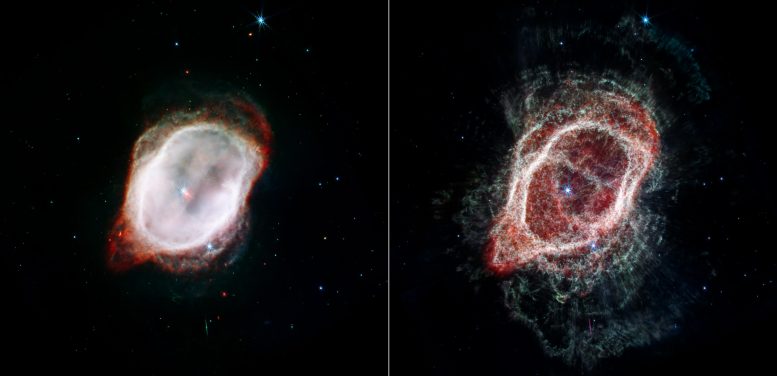
The Webb Space Telescope offers dramatically different views of the same scene! Each image combines near- and mid-infrared light from three filters.
At left, Webb’s image of the Southern Ring Nebula highlights the very hot gas that surrounds the central stars. This hot gas is banded by a sharp ring of cooler gas, which appears in both images.
At right, Webb’s image traces the star’s scattered outflows that have reached farther into the cosmos. Most of the molecular gas that lies outside the band of cooler gas is also cold. It is also far clumpier, consisting of dense knots of molecular gas that form a halo around the central stars. “One of the things that drew my attention was the strong difference between the images of the hot ionized gas and the cold molecular gas,” explained Isabel Aleman of Federal University of Itajubá (UNIFEI), Brazil. “The hot gas is very smooth, but the cold gas shows these mini clumps, spikes, and arcs. Webb’s images are very, very rich in detail.”
By accounting for the temperatures and gas contents in both areas, inside and outside the band, and by combining Webb’s data with precise measurements from other observatories, she and the research team were able to create far more accurate models to demonstrate when gas was ejected by the central star (which appears red in the image at left).
What about the third star that is visible at the lower-right edge of the band within the nebula? From Webb’s vantage point, it appears within the scene, but isn’t part of the nebula itself. It’s merely “photobombing” this party.
Credit: Science: NASA, ESA, CSA, STScI, Orsola De Marco (Macquarie University), Image Processing: Joseph DePasquale (STScI)
NASA’s Webb Space Telescope Indicates Several Stars ‘Stirred Up’ Southern Ring Nebula
Some of the first data from NASA’s James Webb Space Telescope has shown there were at least two, and possibly three, more unseen stars that crafted the oblong, curvy shapes of the Southern Ring Nebula. Plus, for the first time, by pairing Webb’s infrared images with existing data from ESA’s (European Space Agency’s) Gaia observatory, researchers were able to precisely pinpoint the mass of the central star before it created the nebula. A team of almost 70 researchers led by Orsola De Marco of Macquarie University in Sydney, Australia, analyzed Webb’s 10 highly detailed exposures of this dying star to produce these results.
Their calculations show the central star was nearly three times the mass of the Sun before it ejected its layers of gas and dust. After those ejections, it now measures about 60 percent of the mass of the Sun. Knowing the initial mass is a critical piece of evidence that helped the team reconstruct the scene and project how the shapes in this nebula may have been created.
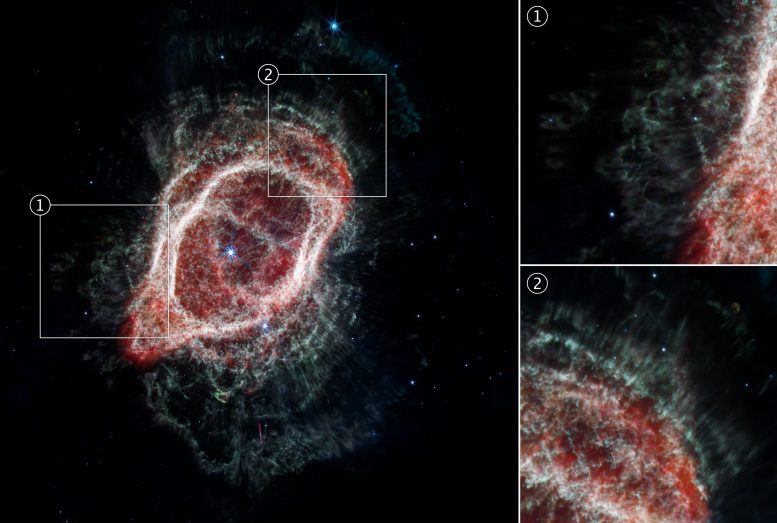
Examine the straight, brightly-lit lines that pierce through the rings of gas and dust around the edges of the Southern Ring Nebula in the Webb Space Telescope’s image. These “spokes” appear to emanate from one or both of the central stars, marking where light streams through holes in the nebula. The holes are evidence of where the dimmer star that created this scene shot out material, creating open pathways for light to flow through.
Some of the star’s ejections followed thin, straight lines (second box) through the gas and dust. Other ejections (first box) look bent, curvy, and thicker. Why? A team of researchers, led by Orsola De Marco of Macquarie University in Sydney, Australia, modeled how these complex structures might have formed. Studies of planetary nebulae have shown that even when dying stars eject their gas and dust at all angles simultaneously, the outflowing gas may not stay symmetrical for long. In the Southern Ring Nebula, the team projects that the straight lines may have been shot out hundreds of years earlier and at greater speeds than those that appear thicker and curvy. It’s possible the second set is a mix of material that slowed, creating less linear shapes.
By carefully comparing the appearance and timing of these ejections in the data and simulations, De Marco and her team propose that this is more evidence of the presence of a star with a slightly wider orbit that “stirred the pot” of ejections.
This image combines near- and mid-infrared light. The dimmer star that created the planetary nebula appears as a faint red star next to the central blue star.
Credit: Science: NASA, ESA, CSA, STScI, Orsola De Marco (Macquarie University), Image Processing: Joseph DePasquale (STScI)
Let’s start with the top-tier celebrity of this particular “party,” the star that sloughed off its layers of gas and dust over thousands of years. It appears red in the image on the left because it is surrounded by an orbiting, dusty disk similar in size to our solar system’s Kuiper Belt. While some stars expel their layers as solo acts “on stage,” researchers propose that there were a few companions with front-row seats – and at least one that may have joined the central star before it began to create the Southern Ring Nebula. “With Webb, it’s like we were handed a microscope to examine the universe,” De Marco said. “There is so much detail in its images. We approached our analysis much like forensic scientists to rebuild the scene.”
It’s common for small groups of stars, spanning a range of masses, to form together and continue to orbit one another as they age. The team used this principle to step back in time, by thousands of years, to determine what might explain the shapes of the colorful clouds of gas and dust.
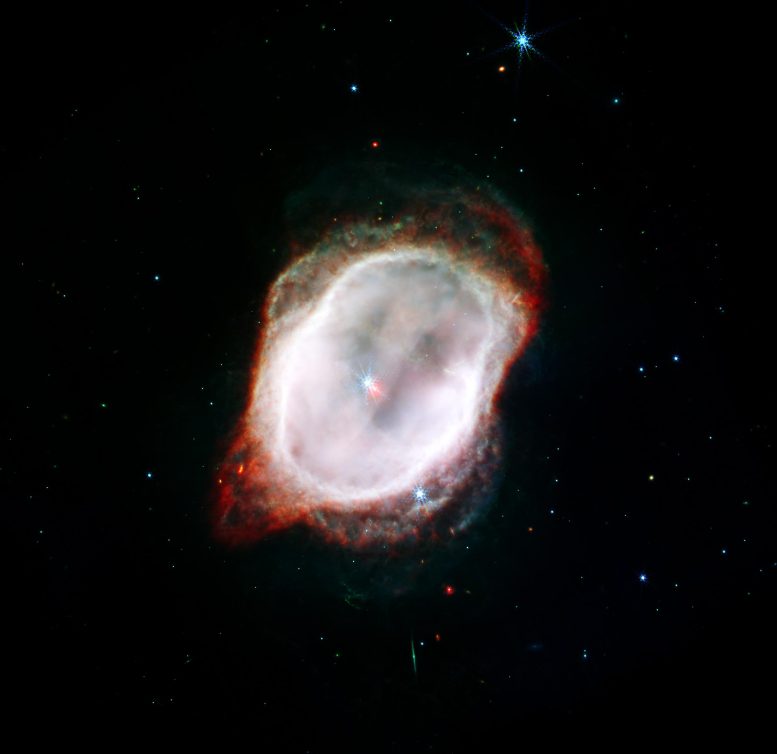
This image of the Southern Ring Nebula (NGC 3132) was captured by Webb’s Near-Infrared Camera (NIRCam) and Mid-Infrared Instrument (MIRI). Credit: Science: NASA, ESA, CSA, STScI, Orsola De Marco (Macquarie University), Image Processing: Joseph DePasquale (STScI)
First, they focused on the aging star that cast off its layers and is still surrounded by a dusty red “cloak” of dust. Extensive research about these types of aging stars shows that dusty cloaks like these must take the form of dusty disks that orbit the star. A quick dive into the data revealed the disk. “This star is now smaller and hotter, but is surrounded by cool dust,” said Joel Kastner, another team member, from the Rochester Institute of Technology in New York. “We think all that gas and dust we see thrown all over the place must have come from that one star, but it was tossed in very specific directions by the companion stars.”
Before the dying star shed its layers, the team proposes that it interacted with one or even two smaller companion stars. During this intimate “dance,” the interacting stars may have launched two-sided jets, which appeared later as roughly paired projections that are now observed at the edges of the nebula. “This is much more hypothetical, but if two companions were interacting with the dying star, they would launch toppling jets that could explain these opposing bumps,” De Marco explained. The dusty cloak around the dying star points to these interactions.
Where are those companions now? They are either dim enough to hide, camouflaged by the bright lights of the two central stars, or have merged with the dying star.
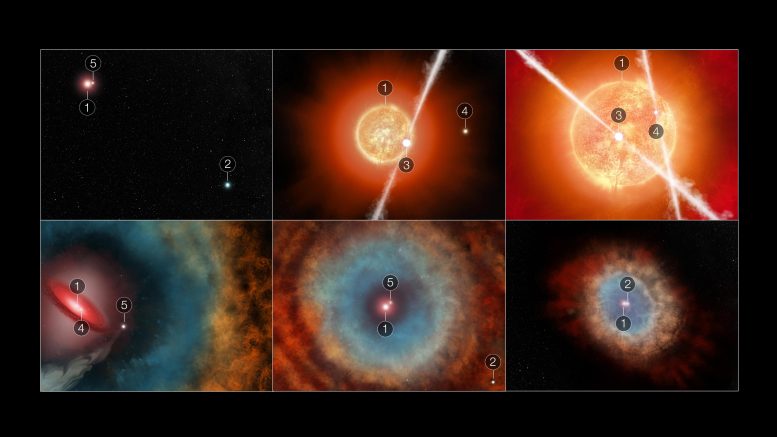
How did all the “partygoers” – up to five stars – create the Southern Ring Nebula? Let’s hit “rewind” and replay the interactions that might have created the scene!
First, it’s important to know that none of these illustrations are properly scaled, and three or as many as four of the stars would be too small and dim to appear in Webb’s image. Second, star 1 and star 2 are the only stars we see in the sixth and final panel above. The remaining “guests” will be known as stars 3, 4, and 5. They are all much less massive – in other words far smaller and dimmer – than stars 1 and 2.
The first illustration shows a wider field. Star 1, the most massive of this group of five stars, is the fastest to age and is responsible for creating the planetary nebula. Star 2 very slowly orbits star 1, which is easier to see in the last panel. All is relatively quiet at this stage as they orbit one another, though there is another star on the scene, number 5. It orbits star 1 far more tightly than star 2 does.
Cue the action! The second panel zooms way in on the scene – and two other companions appear in view. Star 1 has begun to swell as it ages rapidly, swallowing star 3. Through gravity, star 3 starts to draw in material from star 1 and launches jets in both directions. Star 4 is close by, but not yet interacting.
The third panel shows how much star 1 has expanded as it ages. Two companions also enter the mix. Stars 3 and 4 have sent off a series of bipolar jets. As these two stars interact, the jets they sent out are tumbled, which leads to the irregular, wavy edges of the gas and dust ejected by aging star 1. Both companions 3 and 4 are interacting within the gas and dust star 1 has ejected.
In panel 4, we zoom out to see more of the scene. Ultraviolet light and a fast, spherical wind from the newly exposed ultra-hot core of star 1 is helping to carve out its previously ejected gas and dust, creating a bubble-like cavity. There is also a leftover disk of material from the previous interactions with star 3. Star 3 is no longer visible, but star 5 is now in view. It has a wider orbit and is drawing “lines” through the ejected gas and dust from star 1 as it orbits, like a knife through a bowl of icing.
Now, it’s time to zoom out even wider! At this stage, we’re getting closer to a view of the planetary nebula we see today. The fifth panel shows the same trio – stars 1 and 2 with star 5. Now, to mix it up again: As it orbits, star 5 continues to interact with the ejected gas and dust that slowly travels farther and farther from star 1 into the surrounding space, generating the system of large rings seen in the outer nebula.
The sixth panel portrays the scene as we observe it today – by zooming all the way out, we see only stars 1 and 2 in the Southern Ring Nebula.
Now that you’re oriented, read the full recap of the potential events.
Credit: NASA, ESA, CSA, STScI, Elizabeth Wheatley (STScI)
The complex shapes of the Southern Ring Nebula are more evidence of additional unseen companions – its ejections are thinner in some areas and thicker in others. A third closely interacting star may have agitated the jets, skewing the evenly balanced ejections like spin art. In addition, a fourth star with a slightly wider orbit might have also “stirred the pot” of ejections, like a spatula running through batter in the same direction each time, generating the enormous set of rings in the outer reaches of the nebula.
What about the very bright blue-white star in Webb’s images? Think of the fifth star as the most responsible party guest that continues to orbit the dying star slowly, predictably, and calmly.
The two images shown here each combine near-infrared and mid-infrared data to isolate different components of the nebula. The image at left highlights the very hot gas that surrounds the central stars. The image at right traces the star’s scattered molecular outflows that have reached farther into the cosmos.
The team’s paper, entitled ” The messy death of a multiple star system and the resulting planetary nebula as observed by JWST,” was published in Nature Astronomy on December 8.
Reference: “The messy death of a multiple star system and the resulting planetary nebula as observed by JWST” by Orsola De Marco, Muhammad Akashi, Stavros Akras, Javier Alcolea, Isabel Aleman, Philippe Amram, Bruce Balick, Elvire De Beck, Eric G. Blackman, Henri M. J. Boffin, Panos Boumis, Jesse Bublitz, Beatrice Bucciarelli, Valentin Bujarrabal, Jan Cami, Nicholas Chornay, You-Hua Chu, Romano L. M. Corradi, Adam Frank, D. A. García-Hernández, Jorge García-Rojas, Guillermo García-Segura, Veronica Gómez-Llanos, Denise R. Gonçalves, Martín A. Guerrero, David Jones, Amanda I. Karakas, Joel H. Kastner, Sun Kwok, Foteini Lykou, Arturo Manchado, Mikako Matsuura, Iain McDonald, Brent Miszalski, Shazrene S. Mohamed, Ana Monreal-Ibero, Hektor Monteiro, Rodolfo Montez Jr, Paula Moraga Baez, Christophe Morisset, Jason Nordhaus, Claudia Mendes de Oliveira, Zara Osborn, Masaaki Otsuka, Quentin A. Parker, Els Peeters, Bruno C. Quint, Guillermo Quintana-Lacaci, Matt Redman, Ashley J. Ruiter, Laurence Sabin, Raghvendra Sahai, Carmen Sánchez Contreras, Miguel Santander-García, Ivo Seitenzahl, Noam Soker, Angela K. Speck, Letizia Stanghellini, Wolfgang Steffen, Jesús A. Toalá, Toshiya Ueta, Griet Van de Steene, Hans Van Winckel, Paolo Ventura, Eva Villaver, Wouter Vlemmings, Jeremy R. Walsh, Roger Wesson and Albert A. Zijlstra, 8 December 2022, Nature Astronomy.
DOI: 10.1038/s41550-022-01845-2
The James Webb Space Telescope is the world’s premier space science observatory. Webb will solve mysteries in our solar system, look beyond to distant worlds around other stars, and probe the mysterious structures and origins of our universe and our place in it. Webb is an international program led by NASA with its partners, ESA (European Space Agency) and CSA (Canadian Space Agency).

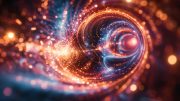



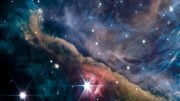


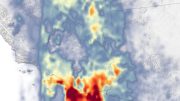
Be the first to comment on "Webb Space Telescope Reveals “Stirred Up” Secrets of Breathtaking Planetary Nebula"